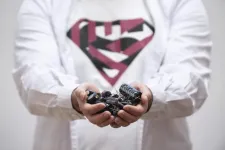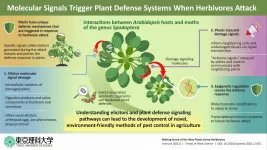Highway tunnel for ions
2021-02-16
(Press-News.org) We live in modern times, that is full of electronics. Smartphones, laptops, tablets, and many other devices need electrical energy to operate. Portable devices made our lives easier, so novel solutions in clean energy and its storage are desirable. Lithium-ion (Li-ion) batteries are the most common solutions that dominate the global market and are a huge problem due to their insufficient recovery. Because of their limited power, short cycle life, and non-environment-friendly nature, scientists recently focused on novel solutions like supercapacitors that offer much more than batteries. Why? Let's take a look closer at these devices.
Supercapacitors bring together the properties of a standard capacitor and the Li-ion battery. In practice, these devices store more energy than capacitors and deliver energy faster than batteries. Their secret lies inside, hiding two essential components. The first one is two highly porous electrodes made of the material that conducts electricity; these electrodes are separated by a membrane to prevent a shortcut. The second one is an electrolyte that plays a crucial role in supercapacitors. The electrolyte has a lot of ions that are close to each other and fill the pores. There are two types of ions - positively charged called cations and negatively charged called anions. When the device is turned on (the potential difference is applied between these two electrodes), ions start to travel in and out of the pores (cations and anions move in opposite directions), and the electric current flows. One of the most commonly used materials that maintain porosity is activated charcoal. If pores are large, the device charges fast but stores low energy. If the pores are narrow, the device provides more energy but charges more slowly. Does it mean smaller is better? Yes, however, the ions' velocity thought their travel in the pores needed to be accelerated.
Recently, an international group led by Svyatoslav Kondrat from the Institute of Physical Chemistry, Polish Academy of Sciences (IPC PAS) presented research work describing how to speed up ion transport in narrow pores. Why? To charge the supercapacitor faster. First of all, researchers focused on the theory. They presented slit-like pores with a size of about 0.6 nm, that is, 0.6 meters divided into billion pieces, just slightly larger than the ion itself, while its length was below 20 nm. What a small size! It is even smaller than viruses. When the electrodes are polarized (the external potential is applied to electrodes to push ions in particular directions), the ions outside of the pores rush to the pores. Imagine that they move like cars on a highway, entering a very narrow tunnel. However, instead of two, three, or four lanes going opposite directions, all lanes are merged. When cars go fast, the highway is very crowded, and they may quickly block the tunnel and get stuck in traffic. The same happens to ions. When the potential difference applied to an electrode is varied too fast, ions entering the electrode's pores block the ions who try to leave the pores. In this way, the pores are clogged. What does it mean in practice?
The bad news, it means slower charging (lower power density) of the supercapacitor. The researchers proposed the solution: Let's not push ions too fast but, well, also not too slow; let's adjust the velocity by a tiny step rate. Based on their idea, they performed multiple complex computer simulations that gave promising results. That was a theory. What about practice? Svyatoslav Kondrat says, "We had the simulation results, and we were curious how it works in practice." Experiments performed in Volker Presser (INM, Saarbrücken) used highly porous electrodes filled with ions. Researchers have shown that ions can travel quicker without pore-clogging when treated with tiny electrical impulses instead of abrupt charging or discharging. This way, they found how to accelerate the charging and discharging processes even if the electrode's pores are as narrow as just 0.6 nm. The research was done under an international collaboration and reported on November 30 in the journal Nature Communications.
Svyatoslav Kondrat says, "The results are encouraging. It is exciting that also discharging can be accelerated. It is like making your cars leave the tunnel faster, even though you have control only over the cars outside of the tunnel. This is relevant for some processes like capacitive water desalination, where operation speed is very important".
Their findings open up new opportunities to tremendously accelerate charging and discharging even in subnanometer pores. This approach to the novel solution application can provide a new path for more widespread use of these environmentally-friendly electrochemical devices.
INFORMATION:
[Attachments] See images for this press release:

ELSE PRESS RELEASES FROM THIS DATE:
2021-02-16
Following the civil war outbreak in Syria nearly ten years ago, Israel began admitting wounded Syrians into the country for humanitarian medical treatment.
In accordance with the Israeli government's decision, the Israel Defense Forces, medical corps, health care system and hospitals in the north of the country joined together to provide medical treatment to thousands of wounded Syrians. The logistics of evacuating the injured from the battlefield and transferring them to Israeli territory was often prolonged due to the fact that Israel and Syria are defined as enemy countries.
Most of the wounded were brought to the Galilee ...
2021-02-16
Biophysicists at Ludwig-Maximilians-Universitaet (LMU) in Munch have developed a new theory, which accounts for the observation that cells can perceive their own shapes, and use this information to direct the distribution of proteins inside the cell.
Many cellular processes are critically dependent on the precise distribution and patterning of proteins on the cell membrane. Diverse studies have shown that, in addition to protein-protein interactions and transport processes, cell shape can also have a considerable impact on intracellular pattern formation. Conversely, there are patterning processes in which any dependence on cell form would be deleterious. Using starfish oocytes as a model system, LMU physicists led by Professor Erwin ...
2021-02-16
In shallow water, less than 30 metres, the survival of hard corals depends on photosynthetic unicellular algae (zooxanthellae) living in their tissues. But how does the coral adapt at depth when the light disappears? French researchers from the CNRS, EPHE-PSL and their international collaborators, associated with Under the Pole (Expedition III), have studied for the first time the distribution of these so-called mesophotic corals in the French Polynesian archipelago, from the surface to 120 metres deep (with a record descent of 172 metres). As the amount of light decreases, the coral associates ...
2021-02-16
DARIEN, IL - A new study found that treating obstructive sleep apnea with CPAP therapy increased self-reported physical activity in adults with a history of heart disease.
During a mean follow-up period of 3.7 years, the group treated with CPAP therapy reported approximately 20% higher levels of moderate physical activity compared with the control group. The study also found the CPAP group was more likely to report activity levels consistent with expert recommendations.
"We were pleased to find that our CPAP users reported that they were better able to maintain their levels of activity over the four years of the study, and that they reported fewer limitations in moderate and vigorous activities including those that are important for independent aging, like walking up the stairs," ...
2021-02-16
The researchers used a biophysical method called thermal proteome profiling (TPP) to gain a comprehensive overview of which human proteins are functionally altered during SARS-CoV-2 infection. TPP monitors protein amounts and denaturation temperatures - the points at which proteins heat up so much that they lose their 3D structure. A shift in denaturation temperature indicates that a particular protein has undergone a functional change upon infection, possibly due to the virus hijacking the protein for use in its own replication.
The scientists observed that infection with SARS-CoV-2 changed the abundance and thermal stability of hundreds of cellular proteins. This included ...
2021-02-16
Psycholinguists from the HSE Centre for Language and Brain found that when reading, people are not only able to predict specific words, but also words' grammatical properties, which helps them to read faster. Researchers have also discovered that predictability of words and grammatical features can be successfully modelled with the use of neural networks. The study was published in the journal PLOS ONE.
The ability to predict the next word in another person's speech or in reading has been described by many psycho- and neurolinguistic studies over the last 40 years. It is assumed that this ability allows us to process the information faster. Some recent publications on the English language have demonstrated evidence that while reading, people can ...
2021-02-16
Canadian researchers are the first to study how different patterns in the way older adults walk could more accurately diagnose different types of dementia and identify Alzheimer's disease.
A new study by a Canadian research team, led by London researchers from Lawson Health Research Institute and Western University, evaluated the walking patterns and brain function of 500 participants currently enrolled in clinical trials. Their findings are published today in Alzheimer's & Dementia: The Journal of the Alzheimer's Association.
"We have longstanding evidence showing that cognitive problems, such as poor memory and executive dysfunction, can ...
2021-02-16
Nature has its way of maintaining balance. This statement rightly holds true for plants that are eaten by herbivores--insects or even mammals. Interestingly, these plants do not just silently allow themselves to be consumed and destroyed; in fact, they have evolved a defense system to warn them of predator attacks and potentially even ward them off. The defense systems arise as a result of inner and outer cellular signaling in the plants, as well as ecological cues. Plants have developed several ways of sensing damage; a lot of these involve the sensing of various "elicitor" molecules produced by either the predator ...
2021-02-16
It is almost ten years since the scientific journal Science called optogenetics the "breakthrough of the decade". Put simply, the technique makes it possible to control the electrical activity of cells with pulses of light. With its help, scientists can gain new insights into the functioning of nerve cells, for example, and thus better understand neurological and psychiatric diseases such as depression and schizophrenia.
Established procedure on animal cells
In research on animal cells, optogenetics is now an established technique used in many fields. The picture is different in plant research: transferring the principle to plant cells and applying it widely has not been possible until now.
However, this has now changed: Scientists ...
2021-02-16
Individual variation in the shape and structure of the Achilles tendon may influence our susceptibility to injury later in life, says a study published today in eLife.
The findings suggest that studying individual Achilles tendon shape (or 'morphology') could help with identifying patients at risk of injury and designing new, potentially personalised approaches for treating and preventing Achilles tendinopathy and similar conditions.
The Achilles tendon is the tissue that links the calf muscles to the heel bone. It is fundamental to our movement and athletic ability. Its unique structure, which combines three smaller sub-tendons, increases the efficiency of our movement by allowing individual control from connected muscles. For this control to occur, the ...
LAST 30 PRESS RELEASES:
[Press-News.org] Highway tunnel for ions



